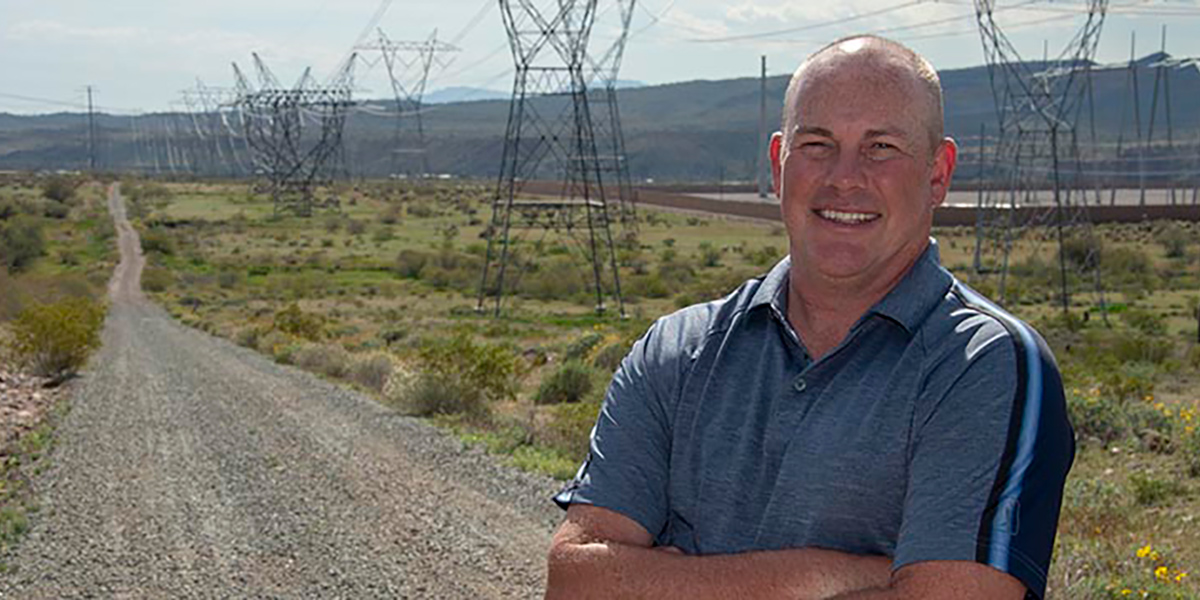CAP employees work each day to ensure Arizona’s allotment of Colorado River water flows through our 336-mile aqueduct to reach our municipal, agricultural, industrial and tribal customers. Learn more about Bryce Dininger from our Power Programs Department via his words below and by watching this video.
Q: In a nutshell, what do you do for CAP?
A: I am in the power programs department, which is a department of two. Brian Young and I manage the fulfillment of the water operations power needs anywhere from an annual to daily basis, which includes generation and transmission management. We are leading the charge in the power procurement process in the post-NGS era. By following the guidelines approved by our board of directors, we are meeting our energy needs with a diversified portfolio that will continue to deliver water at the cheapest energy cost based on market conditions.
Q: How did you get into this line of work?
A: In the late 1990s, I entered into the energy industry by joining a recently launched company that managed portfolio risk based on the needs of the energy cooperative owners. It was somewhat “by chance” that I entered the energy industry and haven’t left.
Q: How does the work you do on a daily basis affect our water supply?
A: We coordinate with water operations monthly, weekly and sometimes on a daily basis to match the least expensive energy price hours with the scheduled water deliveries to our customers. CAP also has the unique ability to deliver water from Lake Pleasant Reservoir. The Waddell Pump/Generating Plant is operated throughout the year, pumping water into the reservoir during winter and spring months while releasing water in the summer months or during canal outages, thus generating power to assist in serving load or market sale
Q: What are some of the technical advances that allow you to do your job more effectively and efficiently?
A: Recently, we gained access to the real-time SCADA data (web-based) that allows us to see our pumping plant energy demand all the way from Mark Wilmer pumping plant at Lake Havasu to the Terminus turnout south of Tucson. We also can view the current generation from Waddell Pump/Generating Plant when releasing water from Lake Pleasant.
Q: What’s the most challenging part of your work?
A: The most challenging part of my work continues to be the understanding of the many water-related acronyms and how they vary from energy acronyms that I have become accustomed to over the last 20 years. I came from a world that included MW (megawatt), ACE (area control error), MMBtu (1 million British thermal unit) and LMP (locational marginal pricing) and have added CFS (cubic feet per second), AF (acre-feet), BOR (Bureau of Reclamation) and MWP (Mark Wilmer Pumping Plant) just to name a few. It is an ongoing challenge that improves daily.
Q: What’s the most gratifying part of your job?
A: For me it has always been gratifying to see results from a strategy or plan that impacts the customers in a positive way. Of course, the flip side is less pleasant, but nonetheless an opportunity to learn why a strategy or plan didn’t have the desired result and how not to repeat it.
Q: What is your favorite part about working at CAP?
A: I truly enjoy driving over parts of our canal, whether it is to the west on I-10, or near Florence onward to Tucson, and knowing I am part of team that is delivering water by a canal that in its construct, is nothing short of a marvel.



